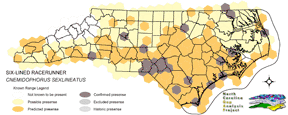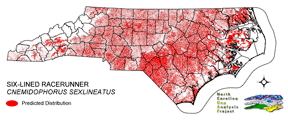
| Taxa: |
| Order: |
| Family: |
| Reptilia |
| Squamata |
| Teiidae |
| NatureServe Global Rank: |
| NatureServe State (NC) Rank: |
| G5 |
| S5 |
| Federal Status: |
| NC State Status: |
| --- |
| --- |


| Land Unit |
| US Fish & Wildlife Service |
| US Forest Service |
| US National Park Service |
| US Department of Defense |
| NC State Parks |
| NC University System |
| NC Wildlife Res. Com. |
| NC Forest Service |
| NC Div. of Coastal Mgmt. |
| Local Governments |
| Non-Governmental Org. |
| Other Public Lands |
| Private Lands |
| GAP Status 1-2 |
| All Protected Lands |
| Statewide |
| Hectares |
| 8,035.65 |
| 16,875.27 |
| 71,496.54 |
| 7,573.41 |
| 8,162.91 |
| 1,928.61 |
| 29,487.33 |
| 3,982.53 |
| 592.74 |
| 1,498.41 |
| 3,030.39 |
| 2,820.60 |
| 4,742,476.56 |
| 33,281.40 |
| 153,165.99 |
| 4,897,960.95 |
| Acres |
| 19,856.52 |
| 41,699.69 |
| 176,671.76 |
| 18,714.30 |
| 20,170.99 |
| 4,765.70 |
| 72,864.77 |
| 10,119.63 |
| 1,464.69 |
| 3,702.65 |
| 7,488.26 |
| 6,969.85 |
| 11,718,912.51 |
| 82,518.70 |
| 378,759.92 |
| 12,103,401.32 |
| % of Dist. on |
| Prot. Lands |
| 5.2 % |
| 11.0 % |
| 46.6 % |
| 4.9 % |
| 5.3 % |
| 1.3 % |
| 18.6 % |
| 2.6 % |
| 0.4 % |
| 1.9 % |
| 1.9 % |
| 1.4 % |
| < 0.1 % |
| 21.7 % |
| ----- |
| ----- |
| % of Dist. on |
| All Lands |
| 0.2 % |
| 0.3 % |
| 1.5 % |
| 0.2 % |
| 0.2 % |
| < 0.1 % |
| 0.6 % |
| < 0.1 % |
| < 0.1 % |
| < 0.1 % |
| < 0.1 % |
| < 0.1 % |
| 96.8 % |
| 0.7 % |
| ----- |
| ----- |
|
Racerunners occur in much of North Carolina (Palmer and Braswell 1995). They are locally common in portions of the Piedmont and the central and southern Coastal Plain, but are uncommon in the mountains with localized populations primarily along the escarpment and in the far western counties. Racerunners are associated with sunny, dry-mesic or xeric areas with open ground or clumped vegetation and with loose sandy, gravelly or rocky soils (Martof et al. 1980, Mitchell 1994). Habitats where they are found include, fields in agricultural areas, pine-scrub flatwoods, grassland and sandhill communities, gravelly river floodplains, open woodlands, coastal barrier islands, and urban areas (Martof et al. 1980, Palmer and Braswell 1995). Specific habitats include, sandy or gravelly banks and floodplains of streams, open roadsides, sparsely vegetated rocky or talus areas at the base of mountains, woodland edges and open woods, beach dunes, barrens, and scrub flats and thickets of dry landscapes. Racerunners are particularly abundant in dry, sandy areas of the coastal plain. Exposed sandy or rocky soil appears to be very important to population distributions. In Virginia, they have been found on open road embankments in the Piedmont and along railroad cuts in the Shenandoah Valley, and unconfirmed habitats in shale barrens. They will utilize grass clumps and shrub vegetation, such as wax myrtle (Myrica cerifera), for cover and shade. The type of vegetation is not as important as its structure. NATURE SERVE GLOBAL HABITAT COMMENTS: Sunny areas with open ground; grassland, sandhills, sandy or gravelly banks and floodplains of streams, sparsely vegetated rocky areas at base of mountains, woodland edges and open woods, beach dunes. Underground when inactive. Eggs are laid in a nest dug in soft soil or sawdust pile (Mount 1975) or under logs or other sheltering objects (Barbour 1971). |
| Code | Name | Description | NC Natural Heritage Program Equivalent |
| 378 | Ocean Beaches | Open beach sand. | Upper Beach |
| 371 | Maritime Grasslands | Dune grass community consisting of sea oats and beach grasses. | Dune grass, Maritime dry grassland |
| 138 | Coastal Plain Dry to Dry-Mesic Oak Forests | Oak dominated forests of the coastal plain. Includes white oak forests with water oak or northern red oak and hickories as co-dominants. | Dry Mesic Oak Hickory Forest, Basic Oak Hickory Forest, Dry Oak Hickory Forest |
| 97 | Mesic Longleaf Pine | Longleaf pine woodlands without a major scrub oak component. Slash or loblolly pines may be present as well. | Mesic Pine Flatwoods |
| 42 | Xeric Longleaf Pine | Sandhills including a range of longleaf pine density from predominantly wiregrass, scrub oak dominated to true longleaf pine woodland. This does not include mesic or saturated flatwood types. | Xeric Sandhill Scrub, Pine/Scrub Oak Sandhill, Coastal Fringe Sandhill |
| 46 | Xeric Oak - Pine Forests | Mixed forest dominated by yellow pines with white or northern red oaks co-dominating. | Pine Oak Heath |
| 232 | Xeric Pine-Hardwood Woodlands and Forests | Mixed forest dominated by yellow pines with drier oaks including southern red, post, and chestnut oaks. | Dry Oak Hickory Forest |
| 220 | Piedmont Xeric Pine Forests | Dry to xeric pine forests dominated by Virginia pine, shortleaf pine or Eastern Red Cedar. | Pine Oak Heath |
| 226 | Piedmont Xeric Woodlands | Generally post and blackjack oak dominated woodlands. White ash and pignut hickory can be found in combination with Eastern red cedar on glades. | Xeric Hardpan Forest |
| 180 | Agricultural Crop Fields | Farm fields used for row crops. | No equivalent |
| 205 | Agricultural Pasture/Hay and Natural Herbaceous | Farm fields used for pasture grass or hay production, as well as old fields dominated by native and exotic grasses. | No equivalent |
| 214 | Barren; bare rock and sand | Areas of bare rock, sand or clay. | No equivalent |
| 60 | Sand | Exposed sand, predominantly in the sandhills region where disturbance or the extreme site conditions prevent natural regeneration. | No equivalent |
| 202 | Residential Urban | Includes vegetation interspersed in residential areas. Includes lawns, mixed species woodlots, and horticultural shrubs. Vegetation accounts for between 20 - 70% of the cover. | No equivalent |
| 203 | Urban Low-Intensity Developed | Highly developed areas with vegetation accounting for < 20% of the cover. | No equivalent |
| 204 | Urban High-Intensity Developed and Transportation Corridors | Highly developed areas including infrastructure such as roads, railroads. Vegetation represents < 20% of the cover. | No equivalent |
|
Etheridge, K., L. C. Wit, and J. C. Sellers. 1983. Hibernation in the lizard CNEMIDOPHORUS SEXLINEATUS (Lacertilia:Teiidae). Copeia 1983:206-214.
Walker, J. M., et al. 1990. Hybridization between all-female CNEMIDOPHORUS TESSELATUS and gonochoristic CNEMIDOPHORUS SEXLINEATUS. J. Herpetol. 24:388-396. Anderson, R. A., and H. M. Tiebout, III. 1993. The effects of timber management practices on the lizards of xeric pineland habitats:an investigation of the Florida sand pine scrub. Final report to The Nature Conservancy. Wright, J. W., and L. J. Vitt. 1993. Biology of whiptail lizards (genus CNEMIDOPHORUS). Oklahoma Mus. Nat. Hist., Norman, Oklahoma. Mitchell, J. C. 1994. The reptiles of Virginia. Washington, DC: Smithsonian Institution Press. Palmer, W. M., and A. L. Braswell. 1995. Reptiles of North Carolina. North Carolina State Museum of Natural Sciences, University of North Carolina Press, Chapel Hill, North Carolina. Fitch, H.S. 1958. Natural history of the six-lined Racerunner (Cnemidophorus sexlineatus). 52 pp. Fitch, H. S. 1970. Reproductive cycles of lizards and snakes. Univ. Kansas Museum Natural History Miscellaneous Publication 52:1-247. Barbour, R. W. 1971. Amphibians and reptiles of Kentucky. Univ. Press of Kentucky, Lexington. x + 334 pp. Minton, S. A., Jr. 1972. Amphibians and reptiles of Indiana. Indiana Academy Science Monographs 3. v + 346 pp. Mount, R. H. 1975. The Reptiles and Amphibians of Alabama. Auburn University Agricultural Experiment Station, Auburn, Alabama. vii + 347 pp. Behler, J. L., and F. W. King. 1979. The Audubon Society field guide to North American reptiles and amphibians. Alfred A. Knopf, New York. 719 pp. Martof, B. S., W. M. Palmer, J. R. Bailey, and J. R. Harrison, III. 1980. Amphibians and reptiles of the Carolinas and Virginia. University of North Carolina Press, Chapel Hill, North Carolina. 264 pp. Vogt, R. G. 1981. Natural history of amphibians and reptiles of Wisconsin. Milwaukee Public Museum. 205 pp. Collins, J. T. 1982. Amphibians and reptiles in Kansas. Second edition. Univ. Kansas Mus. Nat. Hist., Pub. Ed. Ser. 8. xiii + 356 pp. Hammerson, G. A. 1982. Amphibians and reptiles in Colorado. Colorado Division of Wildlife, Denver. vii + 131 pp. Stebbins, R. C. 1985. A Field Guide to Western Reptiles and Amphibians. Second Edition. Houghton Mifflin Company, Boston, Massachusetts. xiv + 336 pp. Maslin, T. P., and D. M. Secoy. 1986. A checklist of the lizard genus CNEMIDOPHORUS (Teiidae). Univ. Colorado Mus., Contrib. in Zoology No. 1. 60 pp. |
For more information please contact them at:
NC-GAP Analysis Project
Dept. of Zoology, NCSU
Campus Box 7617
Raleigh, NC 27695-7617
(919) 513-2853
www.basic.ncsu.edu/ncgap